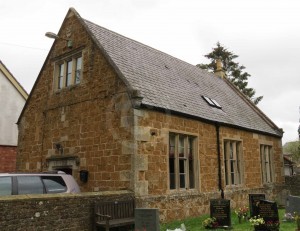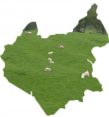
Wymondham is a small village in north-east Leicestershire. Unlike its Norfolk namesake, the name of this Leicestershire village is pronounced as it is written.
The earliest school, in an attractive ironstone building near the church, dates back to 1637 and the will of Sir John Sedley. He left £400 to be used to purchase land, the rent from which was to pay for a schoolmaster to teach the children of that village. His trustees purchased meadow, arable land and a house all in Melton Mowbray, with the land totalling 68 acres upon enclosure of Melton’s open fields in 1761. This brought in rental income of £127 4s. in 1839. Somewhat unusually, the right of nominating the schoolmaster was purchased by Lord Harborough in 1783 for £130. H received all the income, but was responsible for the upkeep of the school building. In 1839 the school had 40 pupils, mostly being taught just the 3Rs (reading, writing and arithmetic), although tuition in Latin, Greek and mathematics was available if the parents wished it. Parents of children in the village paid 5s on admission and the 1s per quarter to cover heating and cleaning, although the children of the poor were admitted for 1s with no further quarterly charge.[1]
By 1818 there were two other schools in the village, teaching about 35 pupils.[2] Two more had opened by 1833, giving a total of five schools for a total population of 746 people, teaching a total of 121 children.[3] Little is known about these schools.
Sir John Sedley’s school continued, due to its secure funding, but as parents began to send their children more often, and for more years, increased accommodation with separate classrooms for children at different levels became necessary. In 1878, a 6-acre site was purchased on the edge of the village for a new school for the more advanced children,[4] and the governors invited tenders for the building.[5] Wymondham Grammar School opened in September 1882, and had accommodation for 25 boarders. On agreeing the revised scheme, the Charity Commissioners stipulated that scholarships with a total annual value of £15 should be provided, and that 10% of the pupils should be educated free. The school would only admit boys who could read, write from dictation and ‘do a few simple sums. They would be taught history, geography, English composition and literature, mathematics, Latin and a modern European language.[6] A church of England school remained in the village to provide a basic education for younger children.
The Grammar School’s governors could not have foreseen that in 1902 all schools would come under the control of the county council, which supported the creation of a small number of grammar schools in more populous places. Notice was given in 1905 that Wymondham Grammar School would close,[7] with the charity income to be diverted to create scholarships at other schools for children from Wymondham and neighbouring villages.[8] These soon included the King Edward VII Grammar School in Melton Mowbray, which opened in 1910.
St Peter’s Primary School opened at the west end of the village in 1968. Its catchment area includes several local villages.
[1] Parl. Papers, Report of Charity Commissioners (1839), pp. 456-7.
[2] Parl. Papers, Education Enquiry (1819), 466.
[3] Parl. Papers, Education Enquiry (1835), 501.
[4] Grantham Jnl, 20 Apr. 1878.
[5] Leicester Jnl, 26 Apr. 1878.
[6] Leicester Chron. 30 Sept. 1882.
[7] Grantham Journal, 25 Feb. 1905
[8] Stamford Merc. 19 Jan. 1906.
